
The bass guitar, electric bass or simply bass is the lowest-pitched member of the guitar family. It is a plucked string instrument similar in appearance and construction to an electric or acoustic guitar, but with a longer neck and scale length. The bass guitar most commonly has four strings, though five- and six-stringed models are also relatively popular, and bass guitars with even more strings or courses have been built. Since the mid-1950s, the bass guitar has largely come to replace the double bass in popular music due to its lighter weight, the inclusion of frets in most models, and, most importantly, its design for electric amplification. This is also due to the fact that the double bass is acoustically compromised for its range in that it's scaled down from the optimal size that would be appropriate for those low notes.

A guitar amplifier is an electronic device or system that strengthens the electrical signal from a pickup on an electric guitar, bass guitar, or acoustic guitar so that it can produce sound through one or more loudspeakers, which are typically housed in a wooden cabinet. A guitar amplifier may be a standalone wood or metal cabinet that contains only the power amplifier circuits, requiring the use of a separate speaker cabinet–or it may be a "combo" amplifier, which contains both the amplifier and one or more speakers in a wooden cabinet. There is a wide range of sizes and power ratings for guitar amplifiers, from small, lightweight "practice amplifiers" with a single 6-inch speaker and a 10-watt amp to heavy combo amps with four 10-inch or four 12-inch speakers and a 100-watt amplifier, which are loud enough to use in a nightclub or bar performance.
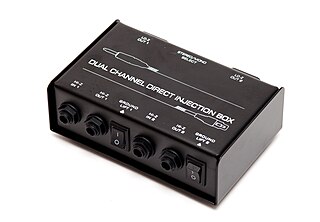
A DI unit is an electronic device typically used in recording studios and in sound reinforcement systems to connect a high output impedance unbalanced output signal to a low-impedance, microphone level, balanced input, usually via an XLR connector and XLR cable. DIs are frequently used to connect an electric guitar or electric bass to a mixing console's microphone input jack. The DI performs level matching, balancing, and either active buffering or passive impedance matching/impedance bridging. DI units are typically metal boxes with input and output jacks and, for more expensive units, “ground lift” and attenuator switches.

The Fender Musical Instruments Corporation is an American manufacturer and marketer of musical instruments and amplifiers. Fender produces acoustic guitars, bass amplifiers and public address equipment; however, it is best known for its solid-body electric guitars and bass guitars, particularly the Stratocaster, Telecaster, Jaguar, Jazzmaster, Precision Bass, and the Jazz Bass. The company was founded in Fullerton, California, by Clarence Leonidas "Leo" Fender in 1946. Andy Mooney has served as the chief executive officer (CEO) since June 2015.
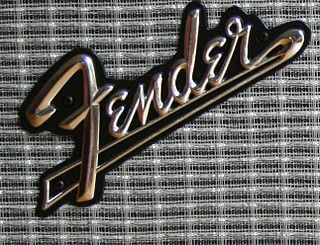
Fender amplifiers are electric instrument amplifiers produced by the Fender Musical Instruments Corporation. The first guitar amplifiers attributed to Leo Fender were manufactured by the K&F Manufacturing Corporation (K&F) between 1945 and 1946. Later, Fender began building its own line of electric guitars. Fender amplifiers would become favorites of guitarists like Jimi Hendrix, Eric Clapton, and Stevie Ray Vaughan, also known in these cases for playing Fender guitars.

A bass amplifier is a musical instrument electronic device that uses electrical power to make lower-pitched instruments such as the bass guitar or double bass loud enough to be heard by the performers and audience. Bass amps typically consist of a preamplifier, tone controls, a power amplifier and one or more loudspeakers ("drivers") in a cabinet.

The Fender Twin and Twin Reverb are guitar amplifiers made by Fender Musical Instruments Corporation. The Twin was introduced in 1952, two years before Fender began selling Stratocaster electric guitars. The amps are known for their characteristically clean tone.
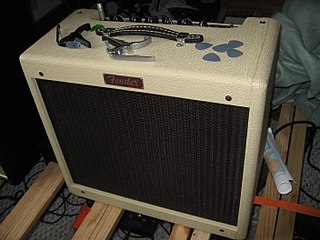
The Blues Junior is a tube guitar amplifier introduced in 1995 by the Fender Musical Instrument Corporation. It is aimed at achieving the warm, tube-driven tone common in many styles of American blues and blues rock dating back to the 1950s, while remaining both portable and affordable. A popular amp, Fender have released numerous versions since its initial release, the most recent being the version IV in 2018. Fender also frequently releases limited editions of the Blues Junior, such as the Lacquered Tweed and the "80 Proof".
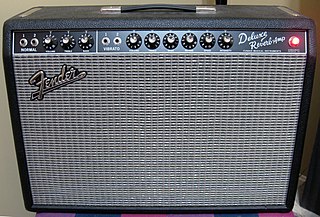
The Fender Deluxe Reverb is a guitar amplifier made by the Fender Electric Instrument Company and its successors. It was first introduced in 1963 by incorporating an onboard spring reverb tank to the newly redesigned Fender Deluxe amplifier.
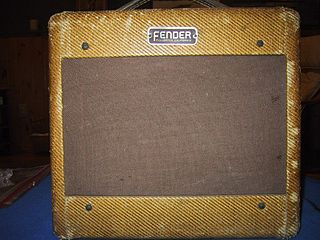
The Fender Champ was a guitar amplifier made by Fender. It was introduced in 1948 and discontinued in 1982. An updated version was introduced in 2006 as part of the "Vintage Modified" line.
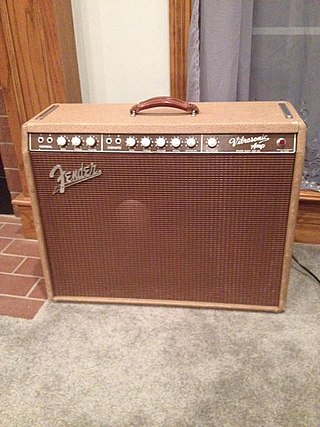
The Fender Vibrasonic was an amplifier made by Fender. It was debuted as the first of the new-model Fender amps of the 1960s, with new tolex-covered cabinets and front-mounted control panels that would replace the tweed-covered, top-panel cabinets that were prevalent during the 1950s, as well as new circuitry which would characterize most Fender amplifiers for two decades.
The Fender Bandmaster Reverb was a tube amplifier made by Fender. It was primarily a Silverface Bandmaster piggyback 'head' with the addition of reverb and vibrato and a modified circuit that shared more similarities with other Fender amplifiers. It was introduced in 1968 and was discontinued in 1980 .The Bandmaster Reverb was produced in both a 40 watt and 70 watt tube variant, before being reissued as a vintage modified amplifier.

The Fender Super was a guitar amplifier made by Fender between 1947 and 1963 and, as the Super Reverb, until 1981. Though it was designed for a clean sound, its overdriven sound is praised by players and critics.
Vintage Guitar is an American magazine that focuses on vintage and classic guitars, amplifiers, effects, and related equipment, as well as notable guitarists from all genres and eras. The publication's feature stories and monthly columns cover a diverse range of topics by contributors, including some of the biggest names in the industry and renowned authorities like Dan Erlewine, George Gruhn, Wolf Marshall, Richard Smith, and Seymour W. Duncan, as well as some of the best-known writers in the field, including Pete Prown, Walter Carter, Dan Forte, Dave Hunter, Rich Kienzle, Michael Dregni, John Peden, Greg Prato, and others.
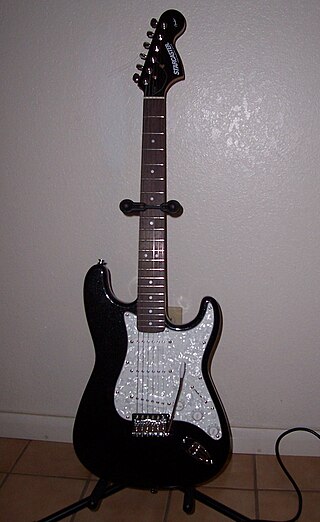
Starcaster by Fender is a range of instruments and accessories aimed at students and beginners, marketed by the Fender Musical Instruments Corporation from the early 2000s until at least 2011. As of April 2018, no products were being marketed under this brand.
The Fender Deluxe guitar amplifier is a range of non-reverb guitar amplifiers produced by Fender. The amplifiers were originally produced from early 1948 to 1966 and reissues are in current production. Its predecessor was the Fender Model 26 "Woodie" produced from 1946 to 1948.

The term backline is used in popular music and sound reinforcement system contexts to refer to electronic audio amplification equipment and speaker enclosures that are placed behind the band or the rhythm section on stage, including amplifiers and speaker cabinets for guitars, bass guitars and keyboards. Such equipment is often rented or leased by the band or their management, or provided by the venue. Speakers placed at the front of the stage facing the performers are also known as monitor speakers or "foldback". The main speakers facing the audience are sometimes referred to as "front of house speakers".
In an amplifier, a presence control boosts the upper mid-range frequencies to make the sounds of voices and instruments with similar tonal ranges seem more "present".
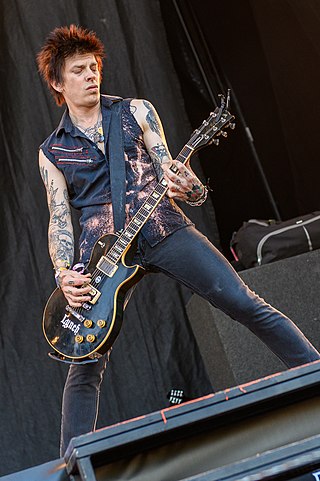
James Patrick Lynch is an American musician. He is a guitarist and a vocalist of the Boston Celtic punk group Dropkick Murphys. Lynch joined the band in 2000 to record the album Sing Loud, Sing Proud. He was previously a member of the Boston-based bands The Ducky Boys and The Pinkerton Thugs. When Marc Orrell left the band in 2008, Lynch was asked to move up to lead guitar, but declined because he enjoyed his position in the band where he only played one instrument. Instead Tim Brennan was moved up to lead guitar and Jeff DaRosa was brought on to play banjo and mandolin. Lynch also played in the band Gimmie Danger along with Marc Orrell, Tim Brennan, and Ben Karnavas.
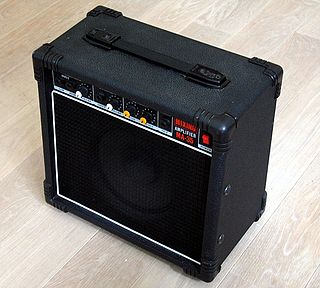
A keyboard amplifier is a powered electronic amplifier and loudspeaker in a wooden speaker cabinet used for the amplification of electronic keyboard instruments. Keyboard amplifiers are distinct from other types of amplification systems such as guitar amplifiers due to the particular challenges associated with making keyboards sound louder on stage; namely, to provide solid low-frequency sound reproduction for the deep basslines that keyboards can play and crisp high-frequency sound for the high-register notes. Another difference between keyboard amplifiers and guitar/bass amplifiers is that keyboard amps are usually designed with a relatively flat frequency response and low distortion. In contrast, many guitar and bass amp designers purposely make their amplifiers modify the frequency response, typically to "roll-off" very high frequencies, and most rock and blues guitar amps, and since the 1980s and 1990s, even many bass amps are designed to add distortion or overdrive to the instrument tone.


















